Gustave Caillebotte
I feel like I’ve known Gustave Caillebotte (1848-1894) ever since I was a young art student on a bus trip to the Art Institute of Chicago. That is where I first saw his very lovely Paris Street; Rainy Day (1877).
So when I first arrived in Paris, I couldn’t help going to the site of Paris Street; Rainy Day in the Place de Dublin behind Gare Saint Lazare. What I didn’t know at the time of my first visit to the Place de Dublin was that I could trace Caillebotte’s footsteps from that scene to the scenes of many of his other paintings, all around his old neighborhood in the 8th arrondissement of Paris.

Geeking out at Place de Dublin, at the corner of rue de Moscou, rue de Tourin and rue de Saint Pétersbourg, the site of Caillebotte’s Paris Street; Rainy Day (1877)
From the Place de Dublin, it is a short walk down rue de Saint-Pétersbourg to the Place de L’Europe which overlooks Gare Saint Lazare, the train station that was the site of many Impressionists paintings. Caillebotte painted an interesting urban scene on the bridge (below) and exhibited the painting in the Second Impressionist Exhibit of 1876.
From the Place de L’Europe, it is just another short walk down rue de Madrid to the lovely neighborhood where the Caillebotte family lived.
In 1866, Gustave Caillebotte’s father bought a plot of land in the nouveau riche neighborhood near Parc Monceau and built a lovely three story townhouse (two more stories would be added after the Caillebottes no longer lived there). It was located on the corner of rue de Miromesnil and rue de Lisbonne. It actually shares two addresses: 77 rue de Miromesnil and 13 rue de Lisbonne. This is where Gustave Caillebotte lived with his parents, his brothers and their servants.
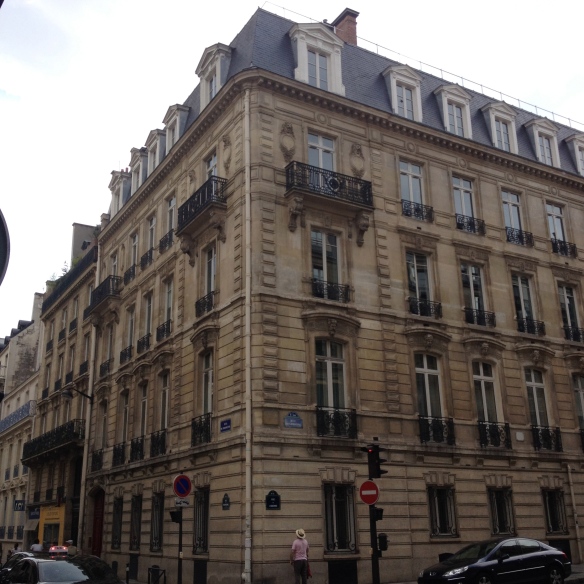
The corner of rue de Lisbonne and rue de Miromesnil in Paris, once the home and studio of the painter Gustave Caillebotte.
Before his death in 1874, Caillebotte’s father Martial built an atelier within the family compound for his artistic son. (Which must have been a true sign of paternal support. Gustave had studied law but preferred the study of art to the practice of law.) It was built on top of a two-story loge used by their concierge, located to the right of the carriage entrance on rue de Lisbonne. Although nothing is left of this structure today, the atelier once consisted of two floors. The top floor had a high-vaulted ceiling, a north-facing skylight, a balcony facing the rue de Lisbonne and French windows to the south.
It is believed that this is exactly where Cailbotte painted the famous The Floor Scrapers (1875), Musée d’Orsay. In fact, art historians believe that the wood scrapers were installing the new wood floor in Caillebotte’s studio at the time. As Michael Marrinan stated in Caillebotte as a Professional Painter, From The Studio to the Public Eye:
The complex lighting of The Floor Scrapers – soft backlighting from the visible window amid a cool, even, interior light – accords perfectly with the studio’s configuration and suggests that Caillebotte was keen to record the good light of his new work space.
Caillebotte was pleased with his work and submitted it to the 1875 Paris Salon. The conservative jury was quick to reject it, finding the subject matter vulgar. Caillebotte had the audacity to paint urban workers with their shirts off with a vaguely erotic mood. (As for me, I love the play of the light from the window, the men’s strong arms, and of course, the bottle of red wine to the side.)
Caillebotte gave up trying to please the Salon jurors and showed this painting in the Second Impressionist Exhibit of 1876, which was held in three rooms in the Durand-Ruel Gallery at 11 rue le Peletier, just off Boulevard Haussman. Although Emile Zola was a friend of the Impressionists, he criticized Caillebotte for being too realistic and too bourgeois. (Critics. You just can’t please them.)
At about the same time, Caillebotte painted his younger brother René standing at one of the windows of the family townhouse. Young Man at the Window was also shown at the Second Impressionist Exhibit. Unfortunately, René would die later that same year. When their mother died just two years later, in 1878, Gustave and his remaining brother Martial moved to a new apartment on Boulevard Haussman.
If you look closely at Young Man at the Window and compare it to the photograph of this building today (above), you can tell that René is standing in one of the corner windows facing rue de Lisbonne, with the intersection of rue de Miromesnil and Boulevard Malesherbes in the background. There was once a stone balustrade in front of this window instead of the iron railing that exists today. In any event, we can be pretty certain that this was not painted in Caillebotte’s new studio, which was located not on the corner, but a little further down rue de Lisbonne.
These days, there is another prominent Frenchman who can be found at this address. I stumbled upon this fun fact quite by accident on a random stroll through the neighborhood. He was having a press conference on the sidewalk outside Caillebotte’s former townhouse, so I stopped to watch the frenzy of the French paparazzi. Yes, that would be Nicolas Sarkozy. In Caillebotte’s footsteps. Quelle surprise! (Do you doubt me? Check out the Paris Match, c’est vrai!)

Caillebotte’s former townhouse, 77 rue de Miromesnil, is now occupied by France’s ex-president Nicolas Sarkozy. His office is located on the first floor (second floor to Americans). So I have to wonder, does Sarkozy ever stand at the window with his hands in his pockets like René Caillebotte?
If your own walk through Caillebotte’s neighborhood leads you into a crazed flock of paparazzi like mine did, you could calm your nerves in the nearby Parc Monceau, a favorite of the Impressionists. Caillebotte painted there himself in the 1870s:

Gustave Caillebotte, Le Parc Monceau (1877) – sold in a 2013 Sotheby’s auction for 2.6 million pounds.

One of Parc Monceau’s “follies” – architectural features of interest from different continents and cultures, as designed by Louis Carrogis Carmontelle in 1778.

Parc Monceau: a bridge designed by Haussman era architect Gabriel Davioud, modeled after the Rialto bridge in Venice.
To finish off what could be a perfect day of all things Caillebotte, I would head over the the Musée D’Orsay to enjoy all of the Impressionist paintings that were part of the Caillebotte Bequest of 1894. By the time of Caillebotte’s death (he was only 45 years old) he had become a leading collector of Impressionist art and one of their most helpful patrons. His bequest to the French government included 67 paintings from artists such as Cézanne, Renoir, Monet, Manet, Sisley and Pissaro. Although the French government refused to accept part of the bequest, those that were accepted now form the heart of the Impressionist Collection of the Musée D’Orsay.
While you’re there, be sure to take an extra moment in front of The Floor Scrapers, and take pleasure in knowing that you’ve walked down the very street where it was painted back in 1875.
My sources, and for your further reading:
Gustave Caillebotte, Urban Impressionist, edited by Anne Distel, Art Institute of Chicago (1995).
Gustave Caillebotte and the Fashioning of Identity in Impressionist Paris, ed. Norman Broude, Rutgers University Press (2002)
Also recommended: Paris Walks Impressionist Walking Tour, April 2015 schedule here — ParisWalks.com holds a “Paris of the Impressionists” Tour almost every month.
“Paris of the Impressionists: This walk includes the lovely Parc Monceau, fine town houses and grand 19thC boulevards. See where the painters lived, worked and set many of their Parisian views: Manet, Monet, Renoir, and Caillebotte’s iconic painting ‘The Rainy Day’. We also hear of their contemporaries: writers, art collectors, benefactors. Meet at metro Monceau.”


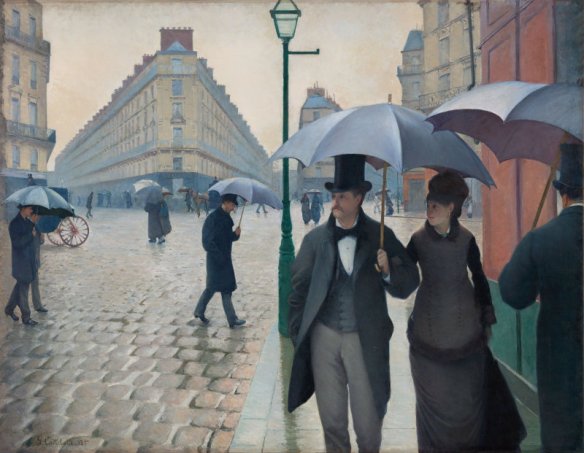




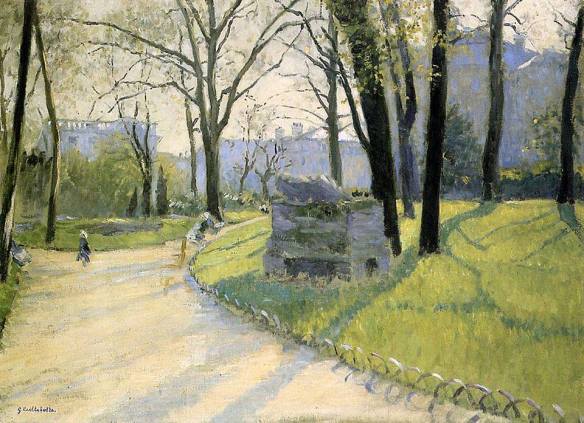
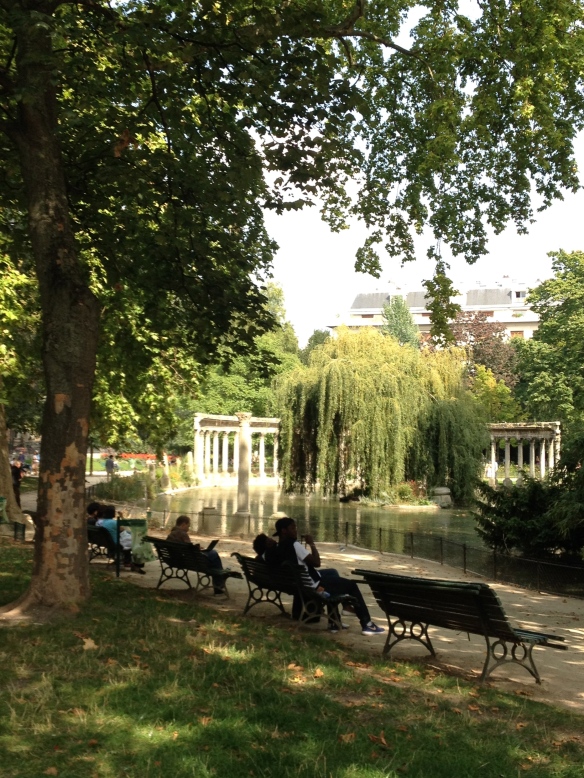
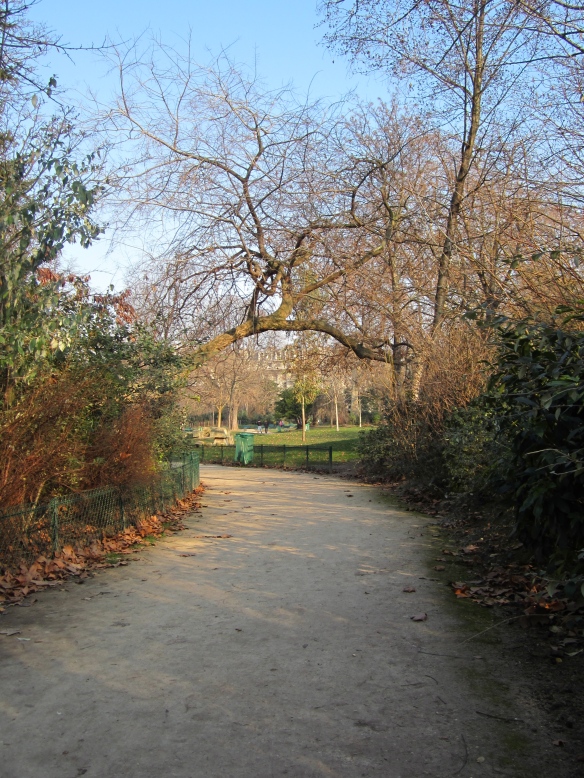


What a fascinating introduction to a painter I am ignorant of until now! Thank you. His work is very appealing.–Carol
LikeLike
I’m not sure if this will reach anyone this long after the original post. I discovered Caillebotte quite by accident after reading an article about his resurgence in Time magazine that featured Paris Street: Rainy Day. A few months later I had the pleasure of seeing the original in Chicago. I have just returned from a trip to France where I was lucky enough to visit the Musée des Impressionisms in Giverny which just happened to have a special exhibit with 80 of his works on display including The Floor Scrapers. Paris Street: Rainy Day may have been the only well known Caillebotte painting that was not on display. I have become a fan for life after seeing this exhibit.
I have a question if anyone can answer it. The Floor Scrapers was on display in the Giverny exhibit which started on 3/25/16. My visit to Giverny was on 6/8/16. I was and still am perplexed because I had seen The Floor Scrapers in the Musée de Orsay when I was in Paris on 5/28/16. I was so taken by it that I took a photo but within 10 days I had seen the same painting by the same artist in two different museums. And they were different paintings. I have photos of both paintings and the one in Giverny appears to be “rougher” and may have been smaller than the one in Paris but is, in all other respects, identical to the one one in the Orsay. I can only guess that he painted it more than once but I can find no explanation for the two works online. Does anyone have an answer?
LikeLike
For those interested, I found the answer to this riddle in an email I received from a curator of the museum in Giverny. Callibotte painted two different versions on the same theme. The one shown in Giverny is a study for the final version that I saw at the Musée d’Orsay in Paris which was presented by Caillebotte in the official Salon of 1875 that was refused by the Jury. That explains why the Orsay painting is bigger (102 x 146 cm) and more “polished” than the version in the Giverny museum. It is difficult to find information on the smaller study because it is in a private collection.
LikeLike
I am aware that Chicago purchased the painting in 1964, but I recall seeing it at the Art Institute much earlier. When was it first shown there?
LikeLike
Check this: https://www.artic.edu/artworks/20684/paris-street-rainy-day
LikeLike